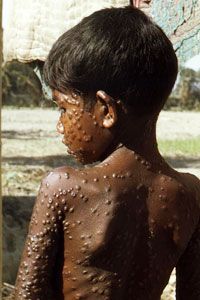Feared Biological Agents
There are many ways to implement a biological attack, but these are some of the most feared agents, from least to most threatening:
- Ebola virus -- The virus takes about a week to kill the victim, and it spreads through direct contact. The Marburg virus is just as deadly.
- Botulinum toxin -- Clostridium botulinum bacteria produce the botulinum toxin, and this toxin is deadly to people in incredibly small quantities (as little as a billionth of a gram). The toxin inhibits the release of the chemicals in nerve cells that cause muscle contractions, so it causes paralysis.
- Tularemia -- Bacteria cause tularemia. The most deadly forms, which cause fever or respiratory illness, kill 5 to 7 percent of people, but vaccines are an effective prevention, and antibiotics can clear the infections [source: Britannica].
- Pneumonic plague -- Plague is caused by a bacterium. In pneumonic plague, bacteria infest the lungs, and a person dies in three to four days if not treated. Pneumonic plague is also contagious, spreading through coughing and sneezing. The most recent pandemic, which lasted until 1922, killed 10 million people. Eventually, public health measures drove the bacteria's hosts, rodents and fleas, out of cities, and antibiotics became available [source: Britannica]. But even today, antibiotics must be delivered fast to prevent death from pneumonic plague. Plague is a weapon. Japan may have released infected fleas in China during World War II, and the United States and Soviet Union found ways to aerosolize the bacteria during the Cold War [source: Britannica].
- Anthrax -- A bacterium causes anthrax. It has a spore form that is very durable. If the spores or bacteria get into your lungs, they reproduce and create a toxin that can be fatal. See "How Anthrax Works" for more information.
- Smallpox -- Smallpox is a virus. It was a major killer until it was controlled with vaccinations in the 20th century. It has been eradicated worldwide, but the fear is that terrorists could release new strains. The main problem with smallpox, unlike with anthrax, is that it is highly contagious. It spreads and kills very quickly. Up to 40 percent of people who catch the virus die from it in about two weeks, and there is no good treatment for the disease. Vaccinations are the main protection, but they must be given prior to infection in order to work.
It would also be possible to cause significant problems by targeting the food supply. For example, foot-and-mouth disease has been a huge problem in Europe. Spreading the disease to the United States would be relatively easy and very disruptive.
Advertisement
